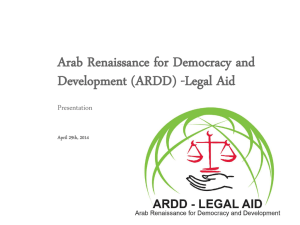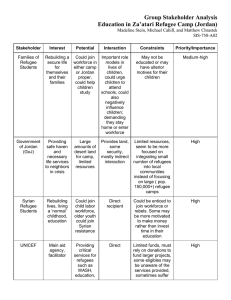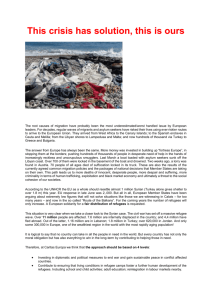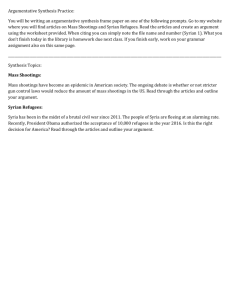Protracted Displacement and Invisible Future: Experiences of Urban Syrian
advertisement
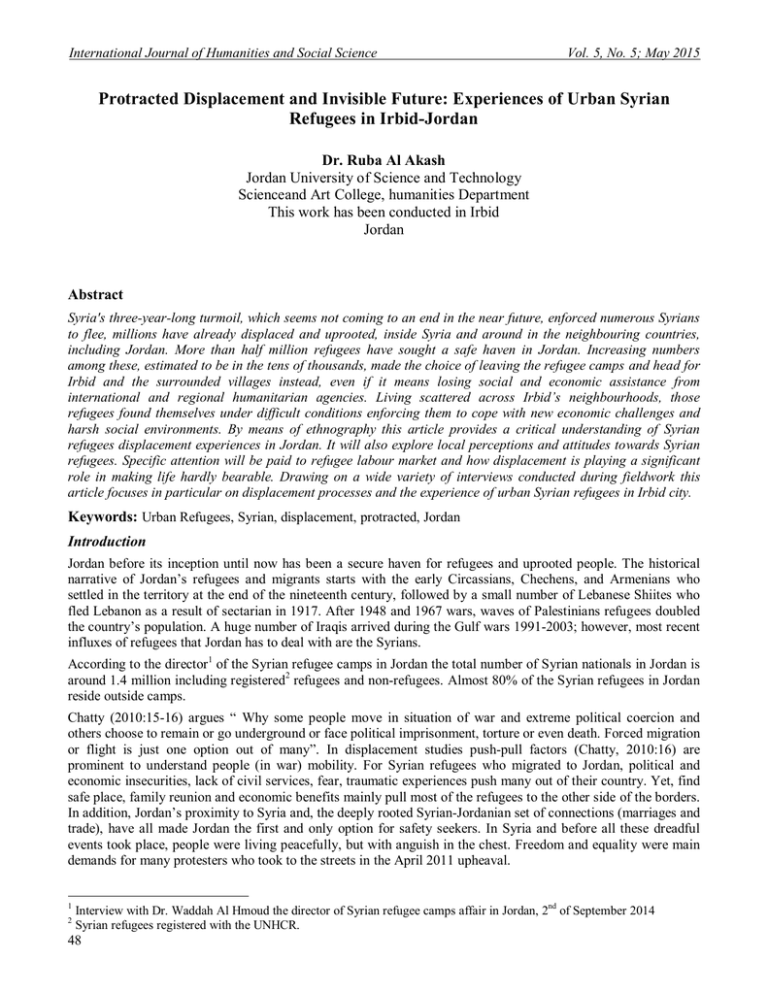
International Journal of Humanities and Social Science Vol. 5, No. 5; May 2015 Protracted Displacement and Invisible Future: Experiences of Urban Syrian Refugees in Irbid-Jordan Dr. Ruba Al Akash Jordan University of Science and Technology Scienceand Art College, humanities Department This work has been conducted in Irbid Jordan Abstract Syria's three-year-long turmoil, which seems not coming to an end in the near future, enforced numerous Syrians to flee, millions have already displaced and uprooted, inside Syria and around in the neighbouring countries, including Jordan. More than half million refugees have sought a safe haven in Jordan. Increasing numbers among these, estimated to be in the tens of thousands, made the choice of leaving the refugee camps and head for Irbid and the surrounded villages instead, even if it means losing social and economic assistance from international and regional humanitarian agencies. Living scattered across Irbid’s neighbourhoods, those refugees found themselves under difficult conditions enforcing them to cope with new economic challenges and harsh social environments. By means of ethnography this article provides a critical understanding of Syrian refugees displacement experiences in Jordan. It will also explore local perceptions and attitudes towards Syrian refugees. Specific attention will be paid to refugee labour market and how displacement is playing a significant role in making life hardly bearable. Drawing on a wide variety of interviews conducted during fieldwork this article focuses in particular on displacement processes and the experience of urban Syrian refugees in Irbid city. Keywords: Urban Refugees, Syrian, displacement, protracted, Jordan Introduction Jordan before its inception until now has been a secure haven for refugees and uprooted people. The historical narrative of Jordan’s refugees and migrants starts with the early Circassians, Chechens, and Armenians who settled in the territory at the end of the nineteenth century, followed by a small number of Lebanese Shiites who fled Lebanon as a result of sectarian in 1917. After 1948 and 1967 wars, waves of Palestinians refugees doubled the country’s population. A huge number of Iraqis arrived during the Gulf wars 1991-2003; however, most recent influxes of refugees that Jordan has to deal with are the Syrians. According to the director1 of the Syrian refugee camps in Jordan the total number of Syrian nationals in Jordan is around 1.4 million including registered2 refugees and non-refugees. Almost 80% of the Syrian refugees in Jordan reside outside camps. Chatty (2010:15-16) argues “ Why some people move in situation of war and extreme political coercion and others choose to remain or go underground or face political imprisonment, torture or even death. Forced migration or flight is just one option out of many”. In displacement studies push-pull factors (Chatty, 2010:16) are prominent to understand people (in war) mobility. For Syrian refugees who migrated to Jordan, political and economic insecurities, lack of civil services, fear, traumatic experiences push many out of their country. Yet, find safe place, family reunion and economic benefits mainly pull most of the refugees to the other side of the borders. In addition, Jordan’s proximity to Syria and, the deeply rooted Syrian-Jordanian set of connections (marriages and trade), have all made Jordan the first and only option for safety seekers. In Syria and before all these dreadful events took place, people were living peacefully, but with anguish in the chest. Freedom and equality were main demands for many protesters who took to the streets in the April 2011 upheaval. 1 2 Interview with Dr. Waddah Al Hmoud the director of Syrian refugee camps affair in Jordan, 2nd of September 2014 Syrian refugees registered with the UNHCR. 48 ISSN 2220-8488 (Print), 2221-0989 (Online) ©Center for Promoting Ideas, USA www.ijhssnet.com Unlike other Arab revolutions that started in big cities such as Egypt and Tunisia, Syrian uprising first flame fired up in undeveloped rural Dera’a, then the unrest escalated to engage other major cities. The displacement process of Syrians started shortly after serious clashes between demonstrators and government forces. The first Syrian refugees arrivals in Jordan were those who have relatives on the other side of the borders mainly from Dera’a, initially they didn’t regarded themselves as “refugees.” Between Al Ramtha in Jordan and the Syrian Dera’a, many families and tribes have been segmented following the division of greater Syria by French and British powers after 1917, for example Al Zoubi, Al Mahamid, Al Masri and Al Khateeb among others have brothers and cousins in both countries each has different identity and passport. Syria's boundary to Jordan Pipes (1990:3) clarifies “appear not as international borders but as something called "regional" borders”.These regional borders are not officially drawn yet, unreal borders apart from fragile wires divided the lands and created different entities. Proximity of the two countries is obvious, in some areas inside Jordan the distance that separate Syrian lands does not exceed three kilometres and sometimes the distance is much less in border towns such as Al Tura, Thonybah, Al Shajara and Emrawa. Through history there were ups and dawns in the Jordanian-Syrian political relations, in spite of this, the normal people remained out of the political loop linked largely by webs of marriage, business and kinship ties. Second exodus of Syrian refugees disembarked after founding Al Za’atari camp in July 2012; the main reason for fleeing was escaping the brutal war and getting more economic benefits. The result was, over three years Jordan has been saturated by massive numbers of refugees. While Jordan is not a signatory to the United Nations Refugee Convention 1951, however, the government maintains the “open door” policy by which Syrian refugees can come and live in Jordan whenever. Syrian refugees in Jordan dispersed in urban and peri-urban areas, from Aqaba city in the extreme south to Irbid in the north. Irbid accommodate refugees from various Syrian cities such as Damascus, Aleppo, Homs, Hamah, nevertheless, Dera’a sent the greater part. Refugee communities are categorised under two distinctions: in camps and urban, normally both follow similar routes to entering Jordan. “Along the 378-km Syrian-Jordanian border there are 25 recognised crossing points and a further 23 that are open depending on the situation” (Al Kilani, 2014:30). Hundreds of thousands of Syrian refugees entered Jordan through the border-like wires without any official documentation, and then to the camps, for many, the camp was just a transitional point to shift to other cities and villages. To exit the camp a refugee has to be “bailed out” by a Jordanian sponsor, like a relative or friend, sponsorship legalise life out of the camps. Most refugees buy the sponsorship from anonymous people and prices vary between 100-200 Jordanian dinars no fixed price. Large numbers of refugees have been smuggled out of the camps without permission or sponsorship. Fleeing the conflict and war was usually the last available option to survive. Many have lost their homes, farms, and businesses back home due to the brutal war. Upon the outbreak of Syrian unrest Jordanian people felt obliged to host the Syrian brothers, many offered, shelter, food and shared their homes, to help in this broad ordeal. On the long run, the numbers of Syrian refugees in the country continued to grow at a high rate every month. The rapid and continuous increase of the refugee population has changed many aspects of host life, increased poverty levels, and exhausted the country's limited resources, infrastructure, and fragile economy. Schools, hospitals and other civil services fell short to provide both local and refugee needs. Housing and employment have also been competition hubs. Secretary General of the Norwegian Refugee Council Jan Egeland argues “Humanitarian organizations have repeatedly warned that the capacity of the host-communities have been stretched to the limits and argued for better international burden-sharing”3. Not surprisingly, potential friction between refugee and host communities is not far from the seen as hostility is increasingly replacing hospitality, needless to say under such conditions insecurity and instability in the country are alarming. Any study of refugees and displacement is necessarily multi-faceted. Initial observations in the field indicated that a focus on ‘refugees legal status and employment’ could be a valuable approach to exploring various interlinked issues, as well as a very complex and sensitive subject to study. A refugee partaking in domestic workforce is a controversial topic in Jordan. The official position that refugees are economic burden, and the common local perception that refugees are new competitors in the local labour market have all emerged recently and debated largely in the localmedia, however, until now this topic still unresolved dilemma. Ethnographic studies about Syrian refugees are scant, especially as for refugees in the urban areas. This paper through ethnography explores the experiences of those protracted Syrians who have sought shelter and work in Irbid-Jordan. It seeks to investigate their experiences of displacement and resettling in new environment. 3 Retrieved from http://www.rescue.org/press-releases/syrian-civilians-unable-escape-22310 49 International Journal of Humanities and Social Science Vol. 5, No. 5; May 2015 This study is not aiming to give the clear-cut answers and present solutions to all of Jordan’s upcoming and current challenges concerning refugee crisis, nevertheless it aims to contribute to the increasing literature on this topic, which is so urgently needed. Research Methodology Over a period of three months, I spent time with many urban Syrian refugees in Irbid, trying to understand “refugee-ness” (Malkki, 1992:25) as a way of life, and displacement as a way of protraction and sometimes as a way of coping with difficulties and struggle. Accessing urban refugee communities in Irbid is sometimes complex, they scattered all over the city’s neighbourhoods however they are always aware of outsiders. Through a friend who owns a real estate and construction company I was able to observe refugees’ mobility in their search of a suitable place to live, and their troubled road to find a decent work. From the start of this research my aim was to integrate as many different voices and perspectives as possible, an approach that underlines the various relationships, between refugees themselves and hosts. This article is based on research conducted with 20 urban Syrian male refugees, and 6 families, 15 interviews were conducted as well with Jordanian male and female citizens, all in Irbid. This location was selected due to my familiarity with the broad-spectrum of the area, and existing contact and connections with the Syrian refugees there. Of these interviewees, seventeen were Syrian from Dera’a province the rest 3 interviews were with Syrian from Damascus and Homs. The age range was between 18-45. This article applying two dominant perspectives: refugee-based perspective on refugee displacement; and an individual and/or community-oriented perspective on refugee life in Irbid. Semi-structured, and unstructured interviews were conducted with all interviewees and in addition to family-centredgroup discussionwas held, including a newly married couple from Damascus. This paper in a broader sense is based on these interviews alongside informal conversations and meetings held with the research participants and observations made throughout the research period. Each interview conducted once in Arabic language, lasted for a minimum of 30 and maximum of 120 minutes each. The interviews were informal in nature and I mostly encouraged interviewees to speak openly. All interviews started with the broad question ‘Can you tell me about your experiences of living in Jordan?’ based on the responses with the interviewees the discussion progressed further. Due to the sensitivity of the employment subject, and to respect the desire of my research participants I have chosen to retain their anonymity. Urban Syrian Refugees Demography in Irbid “ The political situation in Syria was getting from bad to worse, I have six mouths to feed and Ramadan was knocking the doors with no job available and no savings because of the war, I had the feeling that my family would die from hunger, I was indecisive whether to leave or stay, after the bombardment of the local school where I was living and the death of many people, I decided to escaped with my family to Jordan, in a night without moonlight, after living for more than 9 months I discovered the harsh reality not like what I have anticipated, life is hardly bearable without any source of income. (Abu Sabri45 Syriam male August 2014) Abu Sabri is a Syrian refugee man from Dera’a, the head of a family of 7 with his wife, like many of Syrians told his story of displacement with sorrow and grief, for 9 months he is living in a small home in one of northern Irbid’s poverty pockets struggling to cope with his family expenditure, amid no hope of returning back to his homeland again.Until February 2015 the total number of Syrian refugees in Irbid municipality was around 143,3994, raising the population of Irbid alone by over 10%5, however these statistics does not include unregistered or the encamped refugees, therefore, the real number is expected to be much higher. More than half of the refugee population came from Dera’aUNHCR 2014 Syria Regional Response Plan in Jordan6 shows that 54.3% of Syrian refugees in Jordan have originated from Dera’a the Syrian revolution cradle. 4 Retrieved from http://data.unhcr.org/syrianrefugees/region.php?id=74&country=107 See: PDES/2013/13 July 2013 “From slow boil to breaking point: A real-time evaluation of UNHCR’s response to the Syrian refugee emergency” 6 Retrieved from http://www.unhcr.org/syriarrp6/docs/syria-rrp6-jordan-response-plan.pdf 5 50 ISSN 2220-8488 (Print), 2221-0989 (Online) ©Center for Promoting Ideas, USA www.ijhssnet.com Syrian Dera’a before the war took place known to be rural agricultural area, most of its dwellers are Muslim Sunni, work mainly in agriculture and trade, between these communities education levels were low and early marriages among young girls were too very common trend. Syrian refugees live in different situations; a small number of them are rich, and some businessmen granted legal work permission. Most visibly majority of urban and rural refugees are poor, usually arrive empty- handed and brutalized, no money, savings whatsoever, after arriving they end up in small shelters, basements, roofs and sometimes they shared the accommodation to split the cost of high rent, water and electricity bills. Syrian refugees in Irbidlive in all the city’s neighbourhoods, no specific quarters for their aggregations however they prefer to live near each other, these homogenous communities are Muslim Sunni, seem to be Syrian regime opponents, therefore, many of them run away from jail or military conscription. The family size vary typically large, many families headed by women. Poverty levels are high, and work opportunities have constrained by Jordan’s tight legislations regarding Syrian refugees formal employment. Syrian urban refugees largely rely on unequal and inadequate humanitarian relieve provided by various international and local agencies and local people, the aid is very important for their survival. To cope with their financial burdens they resell what left of the food coupons given by the WFP, from time to time work temporarily in various jobs such as construction, maintenance, gardening, guarding, selling goods, and others are selfemployed.While in displacement, family roles may change. “Children – boys in particular, but also girls – are entering the labour market at the expense of their education”.7 This to some extent reflects a social fact caused by displacement of Syrians in Jordan. Women as heads of household work in (sewing, housekeeping, cooking, hairdressing). This type of work is not always an option due to availability. For those Syrians who have been living in urban areas in Irbid and elsewhere in Jordan, they are eligible for medical services at a number of clinics and hospitals. Children are also allowed to join up public schools where there is space. What is creating the big burden for the Syrian refugees more than anything else is home rent, as people need income to keep hold of their living quarters. Work for a Descent….Life Starting from the beginning of October 2014 you will not receive food assistance from the World Food Program based on your data registered with the UNHCR you are able to provide basic needs, to inquire about appeal contact the hotline. (Text message delivered by the UNHCR to the urban Syrian refugees in Jordan). Over 12,000 Syrian refugee families scattered across Jordan’s urban and rural areas received with shook the text message above from the UN’s World Food Programme acknowledging them that their food subsidise on which they survive would not be delivered due to the deficit of financial support from the donor countries. “You are able to provide basic needs” meant to those who have a university degree. Although other international and local humanitarian agencies are trying to assist the urban refugees, however, this help is not enough and unequal, only a small portion of the urban Syrian receives this help; the rest are on their own. Under such circumstances Syrian refugees have sought work in order to live a descent life that met only the basic living requirements. Return back to their country in the near future, is not an option due to the permanence of the brutal war for now at least, therefore they have to build new and secure life in Jordan. The quotations below show some type of work undertaken by refugees. “ I work as a maid, I normally lock my three daughters inside the home and go to work everyday from 9 o’clock in the morning till 3 afternoon, my eldest daughter is 9 years old and she looks after her sisters while I am away, and my husband in Syria, I work just to be able to survive. ” (Om Adam 35 Syrian female September 2014) “I worked as a cleaning man in a big shopping mall in Irbid and I chose the night shift because there is no inspection campaigns from the office of labour at night. Recently I left this job because I had to pay 2 dinars for the taxi everyday to get to my home I was already getting law wage. (Eyad 32 Syrian male August 2014). At work place, few Syrian refugees have experienced exploitation at work such as: work for extra hours without being paid, wage cuts, dismissal from work without a previous notice, harassment and discrimination. The Syrian refugees feel of local resentment and they think Jordanians do not favour the type of work they are taking such as construction and agricultural. 7 Retrieved from http://www.unhcr.org/syriarrp6/docs/syria-rrp6-jordan-response-plan.pdf 51 International Journal of Humanities and Social Science Vol. 5, No. 5; May 2015 ‘Refugee’, as a term, was rejected by many Syrians to be paired with, all emphasised the ideology of pan-Arab hospitability, shared language, culture, heritage and history, where they think they have the right to work and live in Jordan without any restrictions. Challenges and Dilemmas Despite the fact that Jordanian government has tightened its legislations and intensified inspection campaigns regarding Syrian refugees illegal employment, Syrian refugees are still working “illegally” from time to time. Syrian refugees work in open areas like in construction projects where they can easily escape when inspected, or in places far from being visible, or they take night shifts work where there is less or no inspection. Syrians and Jordanians share the same dialect and physical appearance; this creates a big challenge for the work office in Irbid to control the illegal employment. Local empathy with the Syrian refugees very common in Irbid, many Jordanians offered them temporary work to help them go through the economic hardship they face. The Jordanian work owners prefer to recruit Syrians, because they accept lower wages and work for longer hours without complaining, most importantly there is no legal umbrella to protect their work rights. Rashed 45 Jordanian male owns a restaurant in Irbid put it straightforward and confirmed that he likes to hire Syrians more than Jordanians because they work and tolerate more, and complain less. In cases of intensive monitoring by labour office in Irbid, children go to work instead of their fathers and sometimes women. Lack of economic resources has changed familial roles; children and women are becoming more involved in the workforce to generate income. Child labour, begging, prostitution, early marriages have all being practiced by some Syrian refugees as coping mechanisms to their difficult condition, these are huge dilemmas that should be addressed with its negative consequences for the next generations of refugees and locals equally. Long explains, “Refugees’ problems remain two-fold. They first require access to asylum as protection against persecution in their country of origin ………. They then require on-going protection, and finally a solution to exile”. (Long, 2013:8). Considering the fact that Jordan is still protecting and receiving refugees on a daily basis, it is important to find solutions to their protracted exile. To avoid many social and economic problems (mentioned earlier) associated with the presence of Syrian refugees in the country, Jordan government policies regarding refugees’ employment need to be REVISED. Locals Voices Hamza a 35 Jordanian man has lived in Irbid for years with his family. He used to pay 140 dinar a month for his two bedroom residence. Since the Syrian crisis, his rent has almost doubled 250 dinars, he was sure that if he left his home he would not find any cheaper because Syrian refugees accept to pay high rent. Hamza suggested that Syrians should be sent back to their country to end Jordanians struggle. Ziad works as a teacher said: “tell me what has left to us here, Syrians are taking our jobs and chances, they have monthly salary from various agencies and food vouchers, I know Syrian families they get as much as 1000 Dinars per month from the humanitarian agencies, I work all day to get the half”. (42 Jordanian male August 2014). Jordanians in a broader sense perceive Syrians differently from various angles. Some see them as job and livelihood competitor, others believe that Syrians created chaos in the country because they are disorganised. While numerous Jordanians feel of empathy with the Syrians, however these attitudes are taking another turn into unwelcoming. Refugees…the Debate Continues United Nations Refugee Convention in 1951, has defined a refugee as “a person who is outside his or her country of nationality or habitual residence; has a well-founded fear of being persecuted because of his or her race, religion, nationality, membership of a particular social group or political opinion; and is unable or unwilling to avail him— or herself of the protection of that country, or to return there, for fear of persecution” (UNHCR ‘Convention’ Website)8. This research, however, uses the term ‘refugee’ as it is defined by Barbara Harrell-Bond et al “as persons with skills, capacities, and histories that contributed to their host societies and the creation of the refugee regime itself. It is a sad story to acknowledge that today the term ‘refugee’ signals a burden, a victim, and a threat". (Harrell-Bond et al, 2007:295). 8 Retrieved from http://www.unhcr.org/4ec262df9.html 52 ISSN 2220-8488 (Print), 2221-0989 (Online) ©Center for Promoting Ideas, USA www.ijhssnet.com Like many of us, Syrian refugees had their own business and carriers back home, had been filling their family needs, and had been contributing in away or another to their country’s economy. They do have skills, and capacities, therefore, Jordan as a host country can benefit from Syrian skills to fill work shortage in some sectors and other parts of the economy. As mentioned earlier, Jordan is not a signatory of 1951 Convention relating to the Status of Refugees (‘1951 Convention’), no domestic law, or constitution that clearly define the status of a refugee in the country. Jordan is considering the Syrian refugees as GUESTS and or VISITORS. While we are proud of our historic customs of generous hospitability, however, this cultural value should not be adopted as a national policy and strategy, a domestic national legislation should be implemented to categorize and organize the presence of Syrians in Jordan. Facts to Remember A quick solution to the conflict in Syria and subsequent return of the refugees becomes increasingly unlikely. Dealing with the crisis of Syrian refugees, as a dark grey cloud that will disappear after rain, is not a solution, Syrian refugees are protracted in Jordan. Many cannot return to Syrian because of the ongoing conflict or political insecurity. “Jordan supports resettlement but the government refuses to discuss it in the media as it fears it will encourage Syrians to come to Jordan as a ‘gateway’ to third countries”. (Al Kilani, 2014:31). Thus, urban Syrian refugees face massive challenges of protraction and invisible future as they struggle to build new lives in their exile. Replacement of short-term solutions is urgently needed. On the other hand, hunger and poverty are both fertile grounds for crime, violence and social disorder. “Neither the government nor the agencies are able to satisfy all of the refugees' demands. As their requests are frustrated the refugees become suspicious and bitter” (Stein, 1981:327). Free and imprisoned, trapped in traumatic experiences, all can result in losing any sense of hope as days, weeks, and in many cases years continued to drag on into invisible future. Assist urban refugees and neglect the local vulnerable and poor communities is a double-edged sword, it places a base for social disorder and inequality and local antagonism. By considering all the facts presented previously we can all come to one conclusion Jordan’s, social, economic, political, environmental securities are all under threat. Syrians refuge in Jordan is a big burden to shoulder alone, the absence of a national regime for Syrians affair, and the ambiguous status of the Syrians in Jordan is confusing the way how they should be treated, are they Refugees, Guests, Visitors or Migrants. Once we are able to define the Syrian presence in Jordan, we can move one step further into the right direction. Finding successful comprehensive solutions to Syrians displacement is crucial for the development of Jordan’s social, economic and political agendas. Feeding the Syrian refugees is not a solution to the crisis, they may eat today and sleep hungry tomorrow, policy makers in Jordan need to seriously take into account the durable solutions addressed by the UNHCR “voluntary repatriation; local integration; or resettlement to a third country”. By applying these solutions we can reduce refugees suffering, struggle and dependency. Conclusion In this research I have analysed some of the current urban Syrian refugees predicament in Jordan within its massive challenges. This research also was a space where many urban Syrian refugees were able to speak out and address what they feel, and live with. Displacement and forced migration change people’s life maybe for better or for worse, however, most consider it traumatic and painful experiences. As long as human suffering through forced migration revealed, many of these experiences can be heard. The stories and narratives of urban Syrian refugees do not stand alone in this turbulent world, many represent thousands maybe millions of other refugees’ stories around the world. References Al Kilani, S., (2014). In Refugee Studies Centre, Forced Migration Review No. 47 - The Syria crisis, displacement and protection, 2 September 2014, ISSN 1460-9819, available at: http://www.refworld.org/docid/54083d754.html [accessed 9 February 2015]. Chatty, D., (2010).Displacement and dispossession in the modern Middle East. Vol. 5. Cambridge University Press. Harrell-Bond, B., and Eftihia V., (2007). "In search of ‘invisible’actors: barriers to access in refugee research." Journal of Refugee Studies20.2 : 281-298. Long, K., (2013). "When refugees stopped being migrants: Movement, labour and humanitarian protection." Migration Studies mns001. Malkki, L., (1992). "National geographic: the rooting of peoples and the territorialization of national identity among scholars and refugees." Cultural anthropology 7.1: 24-44. Pipes, D., (1990).Greater Syria. Oxford University Press, 1990. Stein, B., (1981). "The refugee experience: Defining the parameters of a field of study." International Migration Review: 320-330. 53

